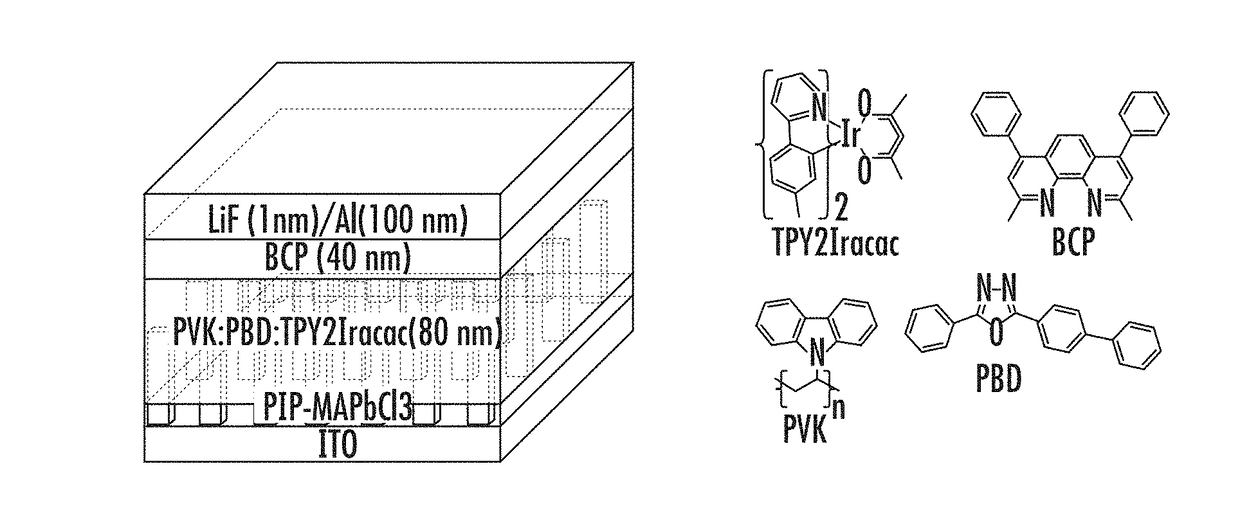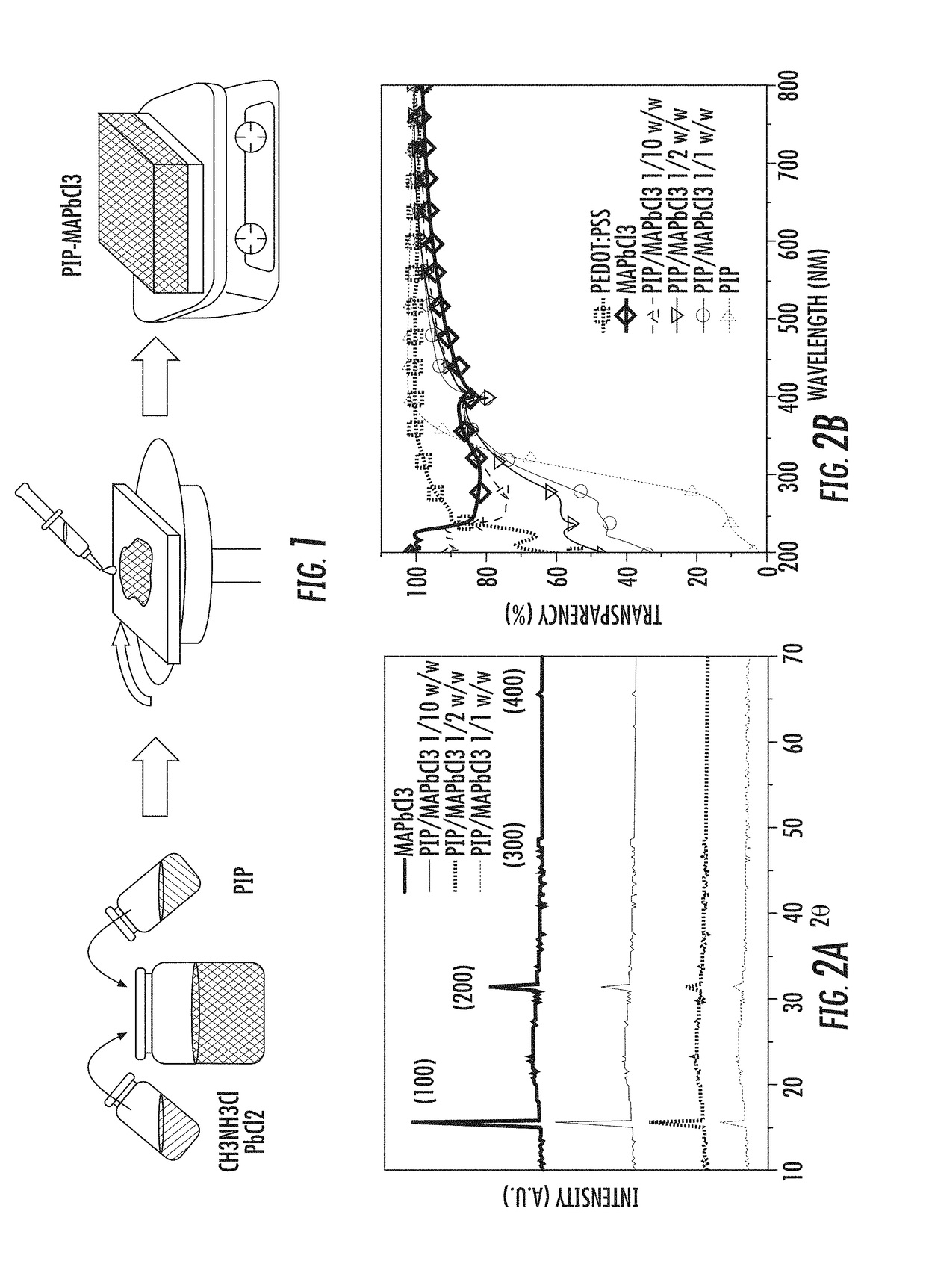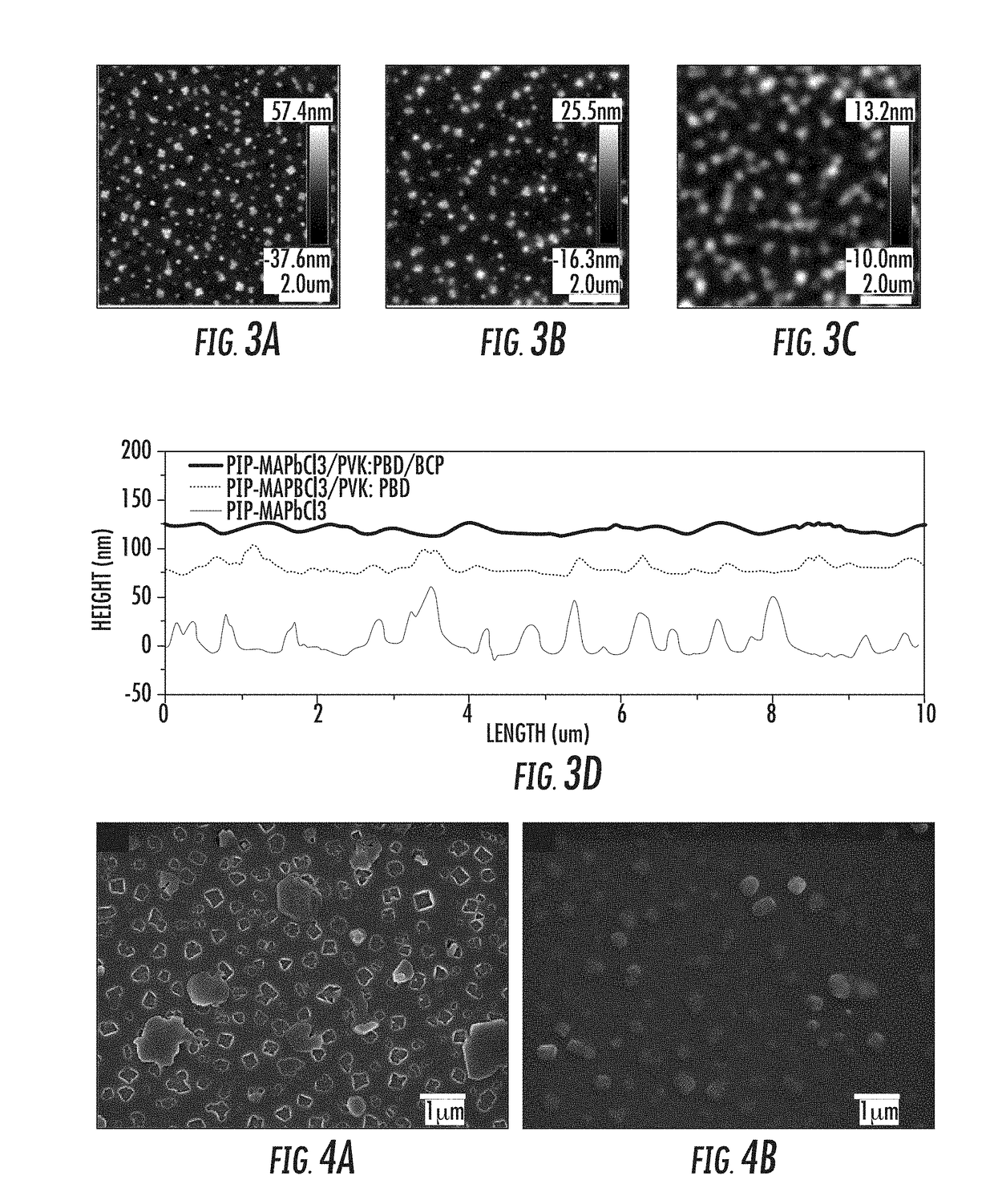Polymer-Perovskite Films, Devices, and Methods
a technology of polymer perovskite and film, applied in the direction of solid-state devices, semiconductor devices, organic semiconductor devices, etc., can solve the problems of weak electron blocking and/or pronounced exciton quenching, many intrinsic limitations of pedot:pss, and difficult preparation of cross-linkable materials
- Summary
- Abstract
- Description
- Claims
- Application Information
AI Technical Summary
Benefits of technology
Problems solved by technology
Method used
Image
Examples
example 1
on of a Polymer-Perovskite Composite Thin Film
[0077]One embodiment of a polymer-perovskite composite thin film was made by the following procedure. CH3NH3Cl and PbCl2 were dissolved in DMF:DMSO mixed solutions (DMF:DMSO,7 / 3,V / V) at concentrations of 0.2 M and 0.1 M, respectively. The CH3NH3PbCl3 precursor solution was prepared by mixing the CH3NH3Cl and PbCl2 solutions at a 1 to 1 volume ratio.
[0078]DMSO was used because it was believed that it enhanced the solubility of CH3NH3PbCl3. By mixing a CH3NH3PbCl3 precursor solution and a PIP precursor solution, composite solutions with PIP / Perovskite weight ratios of 1 / 10, 1 / 2, and 1 / 1 were obtained.
[0079]The mixed solution passed through a syringe filter before it was spin casted on substrates at 3000 rpm for 30 seconds. Right after spin casting, thermal annealing was performed at 60° C. for 5 minutes to remove the solvent and fully convert the precursors into PIP-MAPbCl3 composite thin films. Neat MbPbCl3 thin film was prepared by using...
example 2
scent OLEDs Fabrication and Testing
[0081]ITO-coated glass substrates were cleaned by successive sonication in soap solution, deionized water, acetone, and isopropanol for 15 min at 40° C. and UV ozone cleaned for 20 minutes.
[0082]For a device with PEDOT:PSS as HTL, PEDOT:PSS was spin-cast onto the cleaned ITO coated glass substrate at a spin speed of 3000 rpm for 45 s and baked at 140° C. for 20 minutes to get a 40 nm thick thin film.
[0083]For the devices with MAPbCl3 as HTLs, the films were prepared by the method of Example 1.
[0084]After the deposition of HTL, a solution of 13 mg / mL PVK:PBD (70 / 30 w / w) containing 5 wt % of (TPY)2Iracac in chloroform was spin coated on the top at 3000 rpm for 40 s. The thickness was about 80 nm. A 40 nm thick layer of BCP was then deposited at a rate of 1.0 Å / s under high vacuum conditions (−6 Torr).
[0085]After organic film deposition, the chamber was vented, and a shadow mask with a 2 mm wide stripe was placed onto the substrates perpendicular to t...
example 3
of Films
[0087]The topology of the thin films was analyzed by AFM. FIG. 3A is an AFM image of one embodiment of a PIP-MAPbCl3 (1 / 1 w / w) composite HTL. FIG. 3B is an AFM image of one embodiment of the following layers: PIP-MAPbCl3(1 / 1 w / w) / PVK:PBD:(TPY)2Iracac (80 nm). FIG. 3C is an AFM image of one embodiment of the following layers: PIP-MAPbCl3(1 / 1 w / w) / PVK:PBD:(TPY)2Iracac(80 nm) / BCP(40 nm). AFM cross-section profiles of the films of FIG. 3A, FIG. 3B, and FIG. 3C are provided at FIG. 3D (the curves are offset for clarity).
[0088]SEM images of the films also were taken to analyze the top surface morphology. FIG. 4A is an SEM image of one embodiment of an ITO / PIP-MAPbCl3 (1 / 1 w / w) film, and FIG. 4B depicts an SEM image of one embodiment of an ITO / PIP-MAPbCl3 (1 / 1 w / w) / PVK:PBD:(TPY)2Iracac (80 nm) film.
[0089]The morphology of PIP-MAPbCl3 composite thin films on ITO / glass substrates with different weight ratios of PIP / MAPbCl3 was characterized by atomic force microscopy (AFM), as shown ...
PUM
| Property | Measurement | Unit |
|---|---|---|
| power conversion efficiencies | aaaaa | aaaaa |
| power conversion efficiencies | aaaaa | aaaaa |
| width | aaaaa | aaaaa |
Abstract
Description
Claims
Application Information
 Login to View More
Login to View More - R&D
- Intellectual Property
- Life Sciences
- Materials
- Tech Scout
- Unparalleled Data Quality
- Higher Quality Content
- 60% Fewer Hallucinations
Browse by: Latest US Patents, China's latest patents, Technical Efficacy Thesaurus, Application Domain, Technology Topic, Popular Technical Reports.
© 2025 PatSnap. All rights reserved.Legal|Privacy policy|Modern Slavery Act Transparency Statement|Sitemap|About US| Contact US: help@patsnap.com



